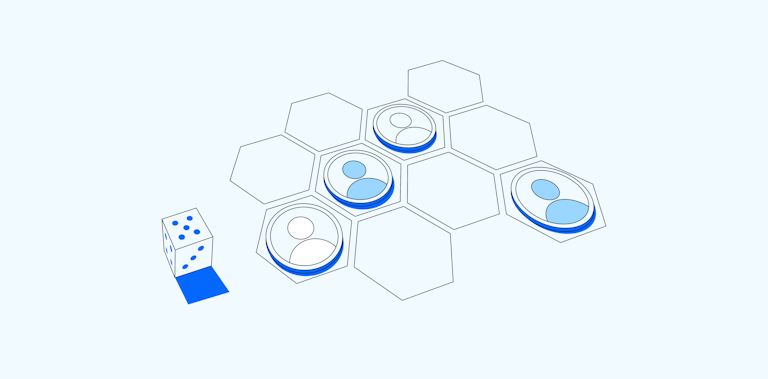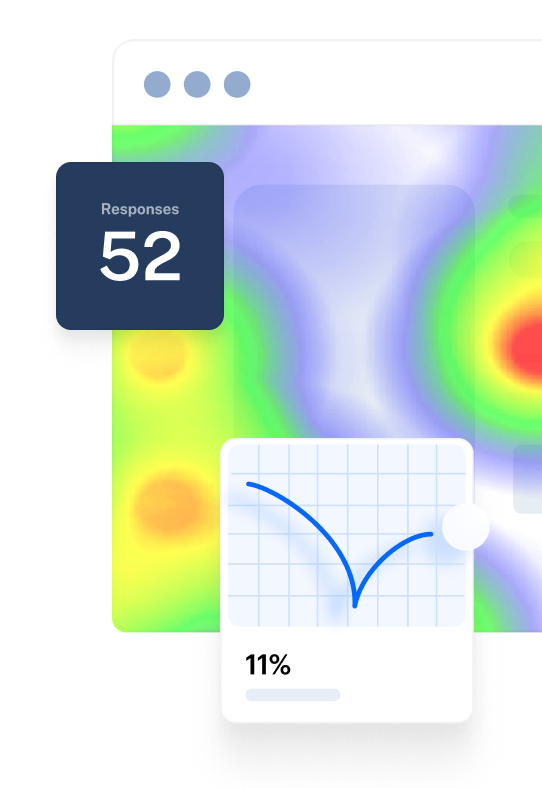Chapter 2
Customer insights strategy: How to create a structure for success

Customer insights serve as the basis for creating data-backed business decisions that retain existing customers and attract new ones.
But, collecting insights is only one piece of the puzzle.
To unlock the full potential of your customer research, you need a systematic plan for efficiently applying customer insights throughout the product development process.
What is a customer insights strategy?
A customer insights strategy is a defined process for collecting, analyzing, and leveraging customer data to optimize business decisions, product quality, and customer experience.
It sets clear intentions for when and how your organization collects and applies customer insights to efficiently enhance product quality and customer loyalty. With a solid strategy in place, you can streamline user research and align stakeholders on delivering customer-centric products.
Why do you need a customer insights strategy at your organization?
Not convinced? Here’s why adopting a customer insights strategy enables you to implement efficient and effective customer research initiatives:
Streamline the research process
A customer insights strategy lays out a structured process using pre-defined user research methods—like UX surveys, moderated user interviews, and social mining—to gather essential insights. This established approach accelerates decision-making and responsiveness to evolving customer needs by providing a clear path for research success and impact.
Clarify stakeholders roles
A customer insights strategy defines team responsibilities for collecting and analyzing insights. This clarity enhances team coordination and helps stakeholders manage the insight process efficiently. Everybody knows their role in the customer insights collection and implementation process, and can therefore act accordingly.
Budget for customer research
Identifying the necessary resources and tools for your customer insights strategy enables accurate budget-forecasting and efficient cost management. Understanding your budget needs from the start prevents resource waste and ensures successful project funding.
Facilitate benchmarking and reporting
A customer insights strategy helps determine KPIs and benchmarks to measure success. These usability metrics enable you to create structured UX reports that update your team and track progress consistently. This means you can modify your strategy as you go based on what’s working and what isn’t.
Democratize insights across your organization
A clearly defined strategy puts everybody on the same page when it comes to using customer insights for making informed decisions. This empowers your team and democratizes user insights across the entire organization—enabling everyone to autonomously work with user feedback, collected by the Product or UX team.
Enable cross-team collaboration
A unified strategy facilitates collaboration across departments, ensuring teams work towards a shared, customer-centric goal. Shared insights promote integrated efforts and leverage diverse expertise and perspectives.
What’s included in a customer insights strategy?
A customer research strategy needs four key components to be efficient and effective. Clearly defining and documenting each element ensures that everyone included in the strategy is aligned. It also helps you foresee any potential roadblocks early on.
Here are four components every customer insight strategy needs:
1. Clearly defined objectives
What is your main goal? Why do you need to collect and implement customer insights? It could be anything from building a new customer-centric product, to improving your current offering, or better understanding your market.
Just like your customer experience strategy, focus on making objectives specific and measurable to avoid confusion among stakeholders and team members.
Customer insights strategy objectives should be broad—unlike individual customer research objectives, which tend to be more specific. Objectives outline the goal that your strategy is working towards.
2. Research methods and tools
You’ll need to choose from multiple customer research methods and tools to ensure you get the right type of insights. This is a crucial part of establishing a customer insight strategy, as it defines how your team will collect and analyze customer insights.
Consider:
- Research participant recruitment: Define how you’ll recruit research participants for your studies. This could be through a customer advisory board, social media, or a participant recruitment platform, like Maze Panel.
- Research methodologies: Settle on research methods like customer experience surveys, interviews, and usability testing to help collect quantitative and qualitative data.
- Customer feedback tools: Choose customer feedback and analytics tools that help you run your desired research studies, collect data, and analyze feedback.
- Customer insights tools: These tools help you process and visualize your findings for the wider organization, making them readable and actionable for team members and stakeholders
3. Customer insights analysis methods
Data isn’t the same as insights. A customer insights strategy should define how you get from one to the other.
To get insights, you need to analyze the data you’ve received from customers. The exact reporting and analysis process will depend on the research methods you opt for, but some key user research analysis techniques include:
- Statistical analysis
- Thematic analysis
- Content analysis
- Grounded theory analysis
Skip ahead to the chapter on customer insights analysis
4. An implementation plan
A clear strategy outlines how you’ll use insights long before you’ve even started collecting them. This process will frequently span across multiple teams—informing everything from product development to marketing strategies.
Consider how the insights you gather will impact wider team decisions, and how to socialize your organization to these changes. Think about things like:
- How your insights could impact product development roadmaps
- Conducting next-step UX research to narrow down ideas
- Surfacing key insights in stakeholder meetings
- Utilizing a UX research repository to store insights
These four main components are the foundations of any customer insights strategy. They’re the bases you need to cover to ensure your strategy is clear, actionable, and understood by the entire team.
Now, let’s take a look at the practical steps to implement a customer insight strategy in your organization.
How to create a valuable customer insights strategy
Here’s four steps to keep insights flowing into your organization and fuelling data-backed decisions.
1. Define your objectives and key stakeholders: Why you collect customer insights and which team members are involved
Begin your strategy by outlining and documenting your objectives. Consider what it is you’re looking to achieve with a customer insights strategy.
A strong option is to align your objectives with customer experience metrics. Some common metrics to consider when outlining objectives include:
- Customer satisfaction score (CSAT): Tells you your customer’s overall satisfaction with your product
- Net Promoter Score® (NPS): Assesses customer loyalty and their likelihood of recommending your product to someone else
- Customer effort score (CES): Measures how easy it is for customers to interact with your product
- Customer retention and churn: Measure how many of your customers stay with your company or are leaving over a specific period
However, not all objectives need to be centered around a metric or KPI. For example, if you’re looking to gather customer insights to inform your next feature, then the objective might simply be to validate a product concept, or build and launch the new feature.
Once you have your objectives, you want to share them with key stakeholders. This will align your team and help you clarify roles and responsibilities. Consider everyone you need onboard, as you’ll likely need buy-in from stakeholders across different departments, such as Marketing, Sales, and UX.
Stakeholders can also provide feedback on your objectives, identify potential roadblocks early on, and offer alternatives. Once you ensure your objective aligns with overall business goals and strategies, you can study customers more closely.
2. Identify your customer personas and develop user journey maps: Who you gather customer insights from
If you don’t already have one, create buyer/user personas—representations of the people who buy your product or services. Include demographic, psychographic, and professional details for each customer segment.
Next, create a customer journey map. This is a visual depiction of every customer's engagement with your brand. With a customer journey map, you can identify friction points and gaps where insights will be especially helpful.
Once you’ve mapped out important points on your customer journey map and have your personas ready, you can begin planning your research initiatives.
3. Assess your resources and outline your customer research process: How you collect and analyze customer insights
One of the most important parts of a customer insights strategy is the research and analysis methodologies. You need to define which approaches work best for your objectives and organization.
Some popular research methods include:
- Customer experience surveys: Get quantitative and generalizable data on your customers, helping you efficiently assess benchmarks like customer satisfaction or net promoter scores
- Interviews and focus groups: For qualitative information on your customers or a whole market segment, helping you uncover the why behind your customers’ behavior, motivations, and preferences
- Sentiment analysis and social media listening: Get real-time data on customer sentiments, opinions, and trends, which you can use to identify particular gaps in the customer experience
- Usability and live website testing: To track clicks, scrolls, and other digital experience signs to help better understand how customers interact with your digital product
You also need to consider how you’ll analyze this customer insights data.
If you’ve chosen a qualitative research method like interviews or focus groups, you could opt for thematic analysis. This process involves reading through transcripts, coding information, and identifying overarching themes to identify insights.
Quantitative data, like that generated from closed-ended surveys and usability testing, use statistical analysis to arrive at generalizable insights such as satisfaction rates and percentages.
Once you’ve set up your research process, you have a structured way to keep insights flowing in. Now, it’s time to outline how to apply them.
💡 Maze’s Automated Reports make it quick and easy to get shareable, actionable reports
4. Define your next steps following customer research: How to share and use customer insights
The insights are in! Now’s the time to establish a framework for interpreting and applying insight-based solutions across teams.
This section of your customer insights strategy should outline:
- Prioritization criteria: Order insights based on their potential impact on your objectives and long-term business goals
- Implementation roadmap: Create a set of standardized steps for turning insights into actionable plans complete with timelines and milestones
You also want to clarify how you’ll share insights across the team. Kirsty Finlayson, Director of Marketing at Chameleon, shares how the entire team has access to customer insights to help inform the decisions they make in individual departments:
“We’re a very vocal team when it comes to customer insights. Day-to-day, you’ll find ad hoc updates shared in our Slack channels. Everything we do on Slack at Chameleon is shared in a public channel, which means you get a lot of passive visibility into these insights. Monthly, we have a full-team deep dive into the metrics from the previous month, and these learnings are shared with everyone.”
It’s as simple as that. Following the steps above enables you to create a strategy for collecting customer insights that everyone can adhere to.
Applying customer insights to user experience
Even though customer insights play a key part in business success, our Continuous Research Trends report showed that a vast majority of product teams wish they had access to more regular feedback and user insights. Speaking to your customers is the number one way to do this, but don’t make it a one-off.
“You should be collecting customer insights always and often,” says Haley Stracher from Iris Design Collaborative. And it doesn’t have to be a labor-intensive or expensive task. Tap into your existing feedback initiatives, and consider what new channels and research methods can help you create new customer touchpoints and collect insights regularly.
The best time to create and implement a customer insights strategy was when you started planning your product. The second-best time is now. Plant the seeds for your customer insight collection and begin your journey to attracting your ICP.
Next up? A deep dive on customer insights analysis. Read on.
Frequently asked questions about customer insights strategy
What is the goal of customer insights?
What is the goal of customer insights?
The goal of customer insights is to understand user wants, needs, pain points, and expectations. This enables better decision-making throughout an organization.
How can I collect customer insights?
How can I collect customer insights?
You can collect customer insights using several research techniques. This includes interviews, surveys, social listening, product analytics, and more—anything that gives you data on your customers and how they interact with your product or service.



